So, you’ve never eaten bugs? Well, more than half the world thinks you’re really missing out. People in most countries eat insects. Central Americans eat butterfly larvae. South Americans eat beetles. Africans eat ants, caterpillars, termites, and grubs. Asians eat fried crickets. Aborigines eat honey ants.
Bugs have too much of the “Ick!” factor, for you? Can’t stand the creepy way they move. Too many eyes and wiggly legs? Well, think about the crustaceans we already eat. Shrimp, crabs, lobsters — they’re arthropods, just like crickets, lawn shrimp, grasshoppers, spiders, and ants. They’re also scavengers, which means their diets are just as questionable as any bugs.
Among the benefits most often touted by entomophagy (bug eating) advocates are that bugs are high in proteins that are generally more sustainable and environmentally friendly than other animal proteins. Further, insects convert feed into protein more efficiently than chickens, cows or pigs. Also, they emit fewer greenhouse gases and less ammonia and require less land and water to sustain populations sufficient for farming.
Mini-livestock, bugs, are being introduced, as ingredients, in many culinary creations. Humans, on average, already unintentionally ingest an estimated 1 pound of insects a year, mixed in with other foods and the FDA acknowledges that it’s not dangerous to have all these, cooked and processed, incidental insects in our food. In fact, it could even be good for us.
Insects are even popping up on Western high-end restaurant menus, which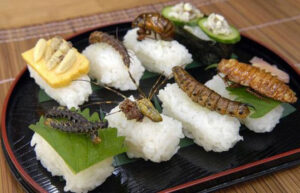 could take bug-eating mainstream, just as raw fish (sushi) has become a Western favorite.
could take bug-eating mainstream, just as raw fish (sushi) has become a Western favorite.
From the Garden to the Table:
Locust: The locust is even mentioned in the bible (Saint James Version) as a source of food sanctioned by God. In the book of Levitic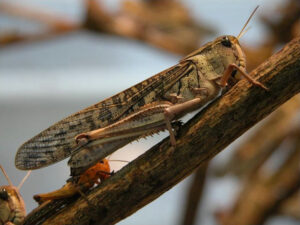 us, Moses and Aaron were instructed, 21 Yet these may ye eat of every flying creeping thing that goeth upon all four, have legs above their feet, to leap upon the earth;
us, Moses and Aaron were instructed, 21 Yet these may ye eat of every flying creeping thing that goeth upon all four, have legs above their feet, to leap upon the earth;
22 Even these of them ye may eat; the locust after his kind, and the bald locust after his kind, and the beetle after his kind, and the grasshopper after his kind.
All locusts are grasshoppers but not all grasshoppers are locusts. Locusts are defined as “short-horned grasshoppers (Orthoptera: Acrididae). How to tell them apart, by their behavior and their population density.
Grasshopper: in Mexico, these are eaten roasted with chili and lime, and are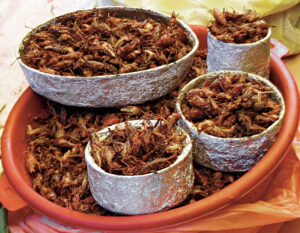 known as chapulines. They are high in protein and calcium.
known as chapulines. They are high in protein and calcium.
June bug: June bugs (Phyllophaga) can be eaten 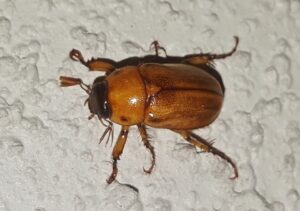 at both the larval and adult stages. Native Americans roasted them over coals and ate them like popcorn.
at both the larval and adult stages. Native Americans roasted them over coals and ate them like popcorn.
Pill-bug: also known as sowbugs or roly-polies, woodlic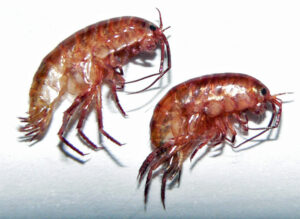 e, lawn shrimp, and springtails – these are actually terrestrial crustaceans, closely related to lobsters, crab,s and shrimp. When boiled, they are said to turn red and have flavors similar to their sea-abiding relatives.
e, lawn shrimp, and springtails – these are actually terrestrial crustaceans, closely related to lobsters, crab,s and shrimp. When boiled, they are said to turn red and have flavors similar to their sea-abiding relatives.
Hornwo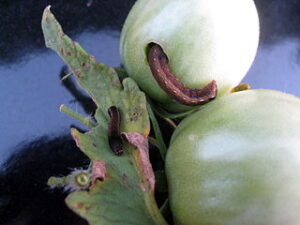 rm: Tomato Hornworms can be fried up much the same as the fruit of the plant on which they feed. They taste a bit like green tomatoes, shrimp, and crab.
rm: Tomato Hornworms can be fried up much the same as the fruit of the plant on which they feed. They taste a bit like green tomatoes, shrimp, and crab.
Agave worm: Also known as the maguey worm, these
larvae of either the Hypopta agavis moth or the Aegiale hesperiaris are sometimes included in tequila bottles as proof of authenticity and alcohol content (tequila must be of high enough proof to preserve the worm). In Mexico, they are also eaten as part of a meal and are highly nutritious.
Ant: Carpenter ants, leaf-cutter ants, honeypot ants, and lemon ants are among edible varieties.
Currently, 2 billion people eat insects around the world, primarily in Africa, Asia, and Latin America, where the practice has a thousand-year history. According to a report by the Food and Agriculture Organization, worldwide, of the 1900 known edible insects, crickets, beetles, caterpillars, bees, wasps and ants are the most widely consumed species.
Here, in the West, insects are pests, destroying crops and gardens alike. Tormenting us by their very presence in and around our homes. We Westerners have developed whole industries centered around the destruction of “Bugs”. But what if we embraced the world view? Our gardens would not only supply us with vegetables and fruits but the harvesting of the pests ruining said gardens would supply us with much-needed nutrition and a very “Green” way of accomplishing “Pest Control”. Just some food for thought.
For an answer to the question, “What do bugs taste like?” Check this out: https://bugible.com/2016/04/11/what-do-insects-taste-like/
For tasty recipes, take a look at these sites:
http://davidgeorgegordon.com/the-bug-chef-2/
https://edibug.wordpress.com/recipes/
Not into bug munching? Need professional help to get rid of insects at your home? Here is a link you may find extremely helpful: https://www.corkyspest.com/
 800-901-1102
800-901-1102
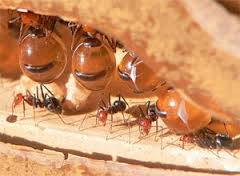
0 Comments